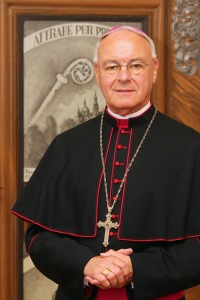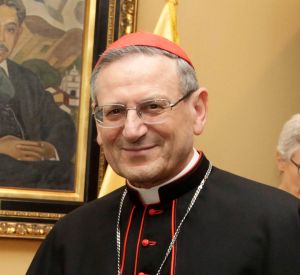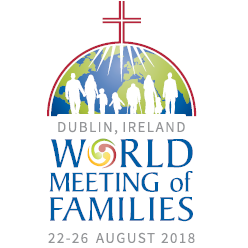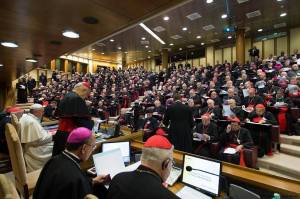Midway through the last month of the year, it is a good time to look ahead to the new year. 2018 will undoubtedly feature its share of Catholic news, developments and, not least, opinions in social media. Every year since the launch of this blog has had had more than a few surprises, so a look at the future can’t be anything but incomplete, but there are a few things which we know will happen.
 The retirement and appointment of bishops is pretty easy to predict, as bishops are legally bound to offer their resignation when they reach the age of 75. Locally, there are currently three dioceses without a bishop: Roermond in the Netherlands, and Hildesheim and Würzburg in Germany. In 2018, two more will likely join these: in Fulda, Bishop Heinz Josef Algermissen (at right) will celebrate his 75th on 15 February, and in Namur, Bishop Remy Vancottem will do likewise on 25 July. A third likely diocese to fall vacant in Ghent. Bishop Luc van Looy will turn 77 on 28 September. Upon his 75th birthday, the diocese made it known that Pope Francis had requested the bishop stay on for two more years, and that extension is up this year.
The retirement and appointment of bishops is pretty easy to predict, as bishops are legally bound to offer their resignation when they reach the age of 75. Locally, there are currently three dioceses without a bishop: Roermond in the Netherlands, and Hildesheim and Würzburg in Germany. In 2018, two more will likely join these: in Fulda, Bishop Heinz Josef Algermissen (at right) will celebrate his 75th on 15 February, and in Namur, Bishop Remy Vancottem will do likewise on 25 July. A third likely diocese to fall vacant in Ghent. Bishop Luc van Looy will turn 77 on 28 September. Upon his 75th birthday, the diocese made it known that Pope Francis had requested the bishop stay on for two more years, and that extension is up this year.
Other predictable events include the 80th birthdays of cardinals, the age at which they cease their duties in the Roman Curia and are no longer able to participate in a conclave. In 2018, six cardinals will mark this milestone:
- Antonio Maria Cardinal Vegliò on 3 February
- Paolo Cardinal Romeo on 20 February
- Francesco Cardinal Coccopalmerio on 6 March
- Manuel Cardinal Monteiro de Castro on 29 March
- Pierre Cardinal Nguyễn Văn Nhơn on 1 April
- Angelo Cardinal Amato on 8 June
 While all hold memberships in various dicasteries in the curia, two of these sit at the head of them: Cardinal Coccopalmerio is president of the Pontifical Council for Legislative Texts and Cardinal Amato (at left) is the prefect of the Congregation for the Causes of Saints. Cardinal Nguyễn Văn Nhơn remains active as archbishop of Hanoi. All will undoubtedly retire upon their 80th birthday, opening up some interesting positions in the curia. Barring any deaths, the number of cardinal electors will stand at 114 by mid-2018. Possibly not low enough for a new consistory by itself, but considering the fact that a further 10 ill age out in 2019, Pope Francis may decide to be proactive and call a consistory in autumn for the creation of anywhere between 6 and 16 new cardinals.
While all hold memberships in various dicasteries in the curia, two of these sit at the head of them: Cardinal Coccopalmerio is president of the Pontifical Council for Legislative Texts and Cardinal Amato (at left) is the prefect of the Congregation for the Causes of Saints. Cardinal Nguyễn Văn Nhơn remains active as archbishop of Hanoi. All will undoubtedly retire upon their 80th birthday, opening up some interesting positions in the curia. Barring any deaths, the number of cardinal electors will stand at 114 by mid-2018. Possibly not low enough for a new consistory by itself, but considering the fact that a further 10 ill age out in 2019, Pope Francis may decide to be proactive and call a consistory in autumn for the creation of anywhere between 6 and 16 new cardinals.
 Speaking about the pope, he will, despite the fact that he has no love for travelling, visit several countries in 2018. In January, he will once again return to South America, visiting Peru and Chile. Ireland is on the schedule in August, when the Holy Father will attend the World Meeting of Families taking place in Dublin (logo at right). Visits not yet confirmed are to the Baltic countries in September and to Romania in December. A visit to India also remains an option, but as Pope Francis has just wrapped a visit to India’s neighbouring countries of Myanmar and Bangladesh, it may not be at the top of the list.
Speaking about the pope, he will, despite the fact that he has no love for travelling, visit several countries in 2018. In January, he will once again return to South America, visiting Peru and Chile. Ireland is on the schedule in August, when the Holy Father will attend the World Meeting of Families taking place in Dublin (logo at right). Visits not yet confirmed are to the Baltic countries in September and to Romania in December. A visit to India also remains an option, but as Pope Francis has just wrapped a visit to India’s neighbouring countries of Myanmar and Bangladesh, it may not be at the top of the list.
 In the latter part of the year, all eyes will be on the Synod of Bishops again, this while the reverberations of the last two assemblies of that body are still being felt. The October 2018 Fifteenth Ordinary General Assembly of the Synod of Bishops while focus on “Young People, Faith and Vocational Discernment”. To this assembly, each bishops’ conference will elect one or more (depending on their size) delegates, while the Pope will also make a personal selection of delegates. One of these personal choices has already been made: Sérgio Cardinal Da Rocha, the archbishop of Brasília, was appointed as Relator General of next year’s assembly. He will outline the theme at the start of the assembly and summarise the delegates’ speeches so they can be condensed into concrete proposals.
In the latter part of the year, all eyes will be on the Synod of Bishops again, this while the reverberations of the last two assemblies of that body are still being felt. The October 2018 Fifteenth Ordinary General Assembly of the Synod of Bishops while focus on “Young People, Faith and Vocational Discernment”. To this assembly, each bishops’ conference will elect one or more (depending on their size) delegates, while the Pope will also make a personal selection of delegates. One of these personal choices has already been made: Sérgio Cardinal Da Rocha, the archbishop of Brasília, was appointed as Relator General of next year’s assembly. He will outline the theme at the start of the assembly and summarise the delegates’ speeches so they can be condensed into concrete proposals.
Photo credit: [1] Bistum Fulda, [2] Fotos Presidencia El Salvador/Wikipedia




 Cardinal Tarcisio Bertone (pictured) will remain on as Camerlengo. He will head the management of the goods and finances of the Holy See. He will also chair the daily meetings of the College of Cardinals for the daily affairs of the Church. Upon the election of the new pope, he will accompany him to the papal apartments and hand him the keys. Cardinal Bertone will also declare the result of every ballot during the conclave. Upon his invitation, the cardinals will meet for discussion and reflection when needed. The vice-chamberlain, Archbishop Pier Luigi Celata, will work with him outside the conclave.
Cardinal Tarcisio Bertone (pictured) will remain on as Camerlengo. He will head the management of the goods and finances of the Holy See. He will also chair the daily meetings of the College of Cardinals for the daily affairs of the Church. Upon the election of the new pope, he will accompany him to the papal apartments and hand him the keys. Cardinal Bertone will also declare the result of every ballot during the conclave. Upon his invitation, the cardinals will meet for discussion and reflection when needed. The vice-chamberlain, Archbishop Pier Luigi Celata, will work with him outside the conclave. During the sede vacante, the archpriests of the papal basilicas will take over the Pope’s liturgical duties. They are Cardinal Agostino Vallini (pictured) for St. John Lateran, Cardinal Angelo Comastri for St. Peter’s, Cardinal James Harvey for St. Paul-Outside-the-Walls and Cardinal Santos Abril y Castelló for St. Mary Major.
During the sede vacante, the archpriests of the papal basilicas will take over the Pope’s liturgical duties. They are Cardinal Agostino Vallini (pictured) for St. John Lateran, Cardinal Angelo Comastri for St. Peter’s, Cardinal James Harvey for St. Paul-Outside-the-Walls and Cardinal Santos Abril y Castelló for St. Mary Major. Cardinal James Harvey (pictured), as the junior Cardinal-Deacon, will lock the doors of the Sistine Chapel before the first ballot. He will be responsible for who enters and leaves during the voting: assistants to those cardinals who may be too ill to be in the Sistine Chapel can leave and return to collect those cardinals’ ballots.
Cardinal James Harvey (pictured), as the junior Cardinal-Deacon, will lock the doors of the Sistine Chapel before the first ballot. He will be responsible for who enters and leaves during the voting: assistants to those cardinals who may be too ill to be in the Sistine Chapel can leave and return to collect those cardinals’ ballots. Come the evening of 28 February, the Church will have to make do without a Supreme Pontiff. For how long, we don’t know, and it is certainly a different situation than the last time this happened.
Come the evening of 28 February, the Church will have to make do without a Supreme Pontiff. For how long, we don’t know, and it is certainly a different situation than the last time this happened. The major event of the sede vacante will of course be the conclave to elect the new Pope. During today’s press briefing, Fr. Federico Lombardi said that this will take place in mid-March, and we’ll have a new Pope before Easter. Barring any deaths, 117 cardinal electors will travel to Rome to participate in the conclave.
The major event of the sede vacante will of course be the conclave to elect the new Pope. During today’s press briefing, Fr. Federico Lombardi said that this will take place in mid-March, and we’ll have a new Pope before Easter. Barring any deaths, 117 cardinal electors will travel to Rome to participate in the conclave.












